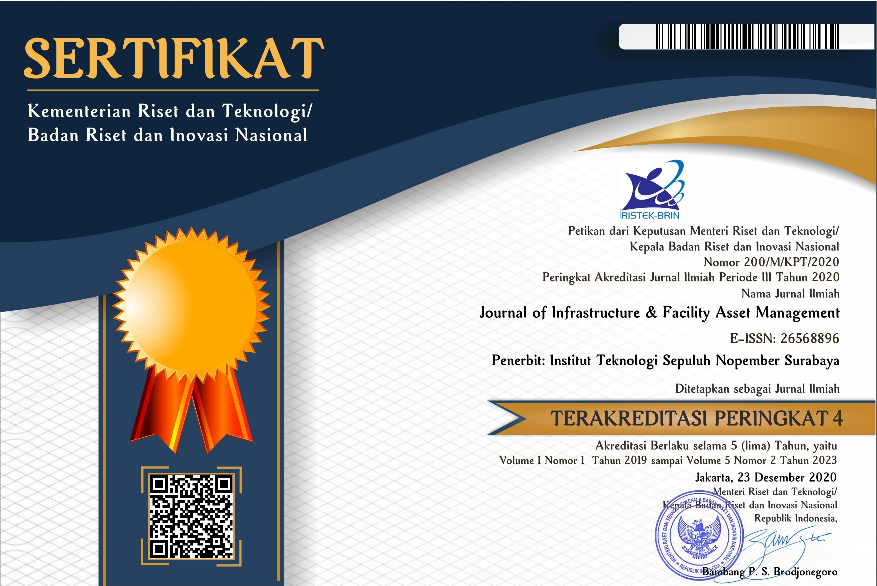Influence of Sustainable Construction Practices Awareness Level on Extent of Usage in Abuja-Nigeria
Abstract
Full Text:
PDFReferences
Abidin, N. Z. (2010). “Investigating the awareness and application of sustainable construction concept by Malaysian developers”. International Habitat, 34, 421-426.
Abolore, A. A. (2012). “Comparative study of environmental sustainability in building construction in Nigeria and Malaysia”. Journal of Emerging Trends in Economics and Management Sciences, 3(6), 951-961.
Aghimien, D. A., Awodele, O. A., Oke, A. E. & Aghimien, E. I. (2018). “Stakeholders’ Perception of Sustainability in Educational Buildings in Nigeria”. International Journal of Sustainable Construction Engineering & Technology, 9(1), 2-11.
Ahn, Y. H. (2013). “Drivers and barriers of sustainable design and construction: The perception of green building experience”. International Journal of Sustainable Building Technology and Urban Development, 4(1), 35-45.
Aigbavboaa, C., Ohiomaha, I., & Zwanea, T. (2017). “Sustainable construction practices: a lazy view of construction professionals in the South Africa construction Industry”. The 8th International Conference on Applied Energy, 3, 951- 956.
Al-Saleh, Y. M. & Taleb, H. M. (2010). “The integration of sustainability within value management practice: A study of experienced value managers in the GCC countries”. Project Management Journal, 41(2), 50–59.
Alex, O. & Chris, F. (2013). “Implementation of sustainable practices in UK construction”. The International Journal of Sustainable Policy and Practice, 8, 122-125.
Ametepey, S. O., Aigbavboa, C. O. & Ansah, S. K. (2015). “Barriers to a successful implementation of sustainable construction in Ghanaian construction industry”. Procedia Manufacturing, 3, 1682-1689, https://doi.org/10.1016/j.promfg.2015.07.988
Bal, M. (2014). Stakeholder engagement and sustainability-related project performance in construction. Unpublished PhD Thesis. John Moores University. Liverpool United Kingdom.
Baloi, D. (2015). “Sustainable construction: challenges and opportunities”. 19th Annual ARCOM Conference, 3–5 September 2003, University of Brighton Greenwood: Association of Researchers in Construction Management, 1, 289-297.
Chinelo, I. (2016). “Fundamentals of research methodology and data collection”. Research Methodology, 4(11). 4-9.
Creswell, J. W. (2014). Research design: Quantitative and mixed methods approach (4th Ed.). Sage Publications. The USA.
Dania, A. A. (2016). Sustainable construction at the firm level: A case study from Nigeria Unpublished PhD Thesis. The University of Reading. England.
Davies, O. O. & Davies I. O. (2017). “Barriers to implementation of sustainable construction techniques”. MAYFEB Journal of Environmental Sciences. 6(1), 1175–1183.
El Razaz, Z. (2010). “Design for dismantling strategies”. Journal for Building Appraisals, 6, 49- 61.
Hamed, T. (2016). “Sampling methods in research methodology: How to pick a sampling technique for research”. International Journal of Academic Research in Management, 5(2), 19-25
Holton, I., Glass. J. & Price, A. (2018). “Developing a successful sector sustainability strategy: Six lessons from the UK construction project industry”. Corporation Society Responsible for Environmental Management, 15, 29-42.
IHS Global Insight. (2016). Global construction outlook. Global Insight. The USA. Lexington, MA.
Kibert, C. J. (2013). Sustainable construction: Green building design and delivery. John Wiley and Sons Inc. New Jersey.
Krejcie, R. V. & Morgan, D. W. (1970). “Determining sample size for research activities”. Educational & Psychological Measurement, 30, 607-610.
Lowe, D. & Zhou, L. (2013). The economic factor of sustainable construction. The RICS Foundation. University of Wolver Hampton London. 113-126.
Murray, P. E. & Cotgrave, A. J. (2007). “Sustainability literacy: the future paradigm for construction education”. Structural Survey, 25, 7-20.
Niroumand, H. Zain, M. & Jamil, M. (2013). “A guideline for assessing of critical parameters on earth architecture and earth buildings as a sustainable architecture in various countries”. Renewable and sustainable energy reviews, 28, 130-165.
Oladokun, G. M., & Ujene, A. O. (2017). “Sustainability assessment in construction organizations' project delivery practice in Nigeria”. Journal of Building Performance, 8, 12-14.
Opoku, A. & Fortune, C. (2011). “The implementation of sustainable practices through leadership in construction organizations”. Proceedings of the 27th ARCOM Conference, Bristol, United Kingdom, 1145 – 1154.
Owolana, V. O., & Booth, C. A. (2016). “Stakeholders perception of the benefits and barriers of implementing environmental management systems in the Nigeria construction industry”. Journal of Environmental Engineering and Landscape Management, 24(2). 79–89.
Sev, A. (2009). “How can the construction industry contribute to sustainable development? A conceptual framework”. Sustainable Development, 17, 161–173.
Udawatta, N., Zuo, J., Chiveralls, K. & Zillante, G. (2015). “Attitudinal and behavioral approaches to improving waste management on construction projects in Australia: Benefits and limitations”. International Journal of Construction Management, 15(2), 137- 147.
DOI: http://dx.doi.org/10.12962%2Fjifam.v3i3.14129
Refbacks
- There are currently no refbacks.
Visitor :
Flag Counter

Journal Of Infrastructure & Facility Asset Management by Institut Teknologi Sepuluh Nopember is licensed under a Creative Commons Attribution-ShareAlike 4.0 International License.





